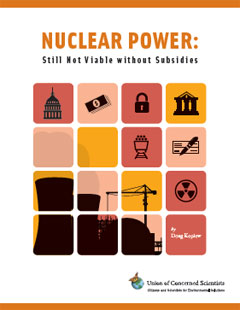Government subsidies to the nuclear power industry over the past fifty years have been so large in proportion to the value of the energy produced that in some cases it would have cost taxpayers less to simply buy kilowatts on the open market and give them away, according to a February 2011 report by the Union of Concerned Scientists.
The report, Nuclear Power: Still Not Viable without Subsidies, looks at the economic impacts and policy implications of subsidies to the nuclear power industry—past, present, and proposed.
How would you like your subsidy?
Nuclear power subsidies vary by type of ownership (public or private), time frame of support (legacy, ongoing, or new), and the type of cost (or “attribute of production”) they address—from startup capital to decommissioning and waste disposal. Subsidies can take many forms, including tax breaks, accident liability caps, direct payments, and loan guarantees.
While the exact value of these subsidies can be difficult to pin down, even conservative estimates add up to a substantial percentage of the value of the power nuclear plants produce—approaching or even exceeding 100 percent in the case of legacy subsidies and subsidies to new privately-owned reactors (see chart).
Subsidies prove addictive
Subsidies were originally intended to provide temporary support for the fledgling nuclear power industry, but the promised day when the industry could prosper without them and power from nuclear reactors would be “too cheap to meter” has yet to arrive. It is unlikely to arrive any time soon, as cost estimates for new reactors continue to escalate and the nuclear power lobby demands even more support from taxpayers. Piling new subsidies on top of existing ones will provide the industry with little incentive to rework its business model to internalize its considerable costs and risks.
Subsidy impacts: Public risks and hidden costs
Nuclear subsidies effectively separate risk from reward, shifting the burden of possible losses onto the public and encouraging speculative investment. By masking the true cost of nuclear power, subsidies also allow the industry to exaggerate its economic competitiveness; consequently, they diminish or delay support for more economical and less risky alternatives like energy efficiency and renewable energy.
Recommendations
The report concludes with a dozen recommendations for policymakers, including reducing subsidies to existing reactors, adopting market-oriented approaches to uranium mining royalties and waste management financing, and incorporating the costs of preventing nuclear proliferation and terrorism into economic assessments of new reactors.




